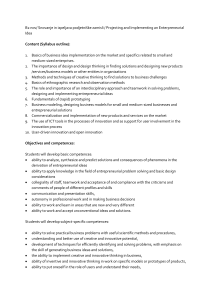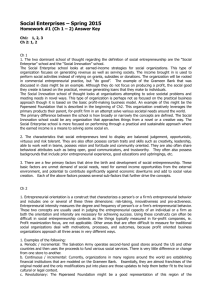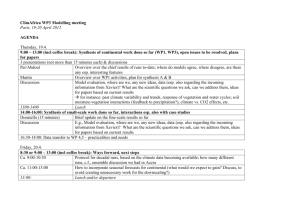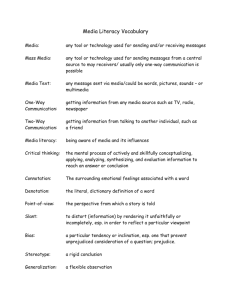Entrepreneurial Skills Pass
advertisement
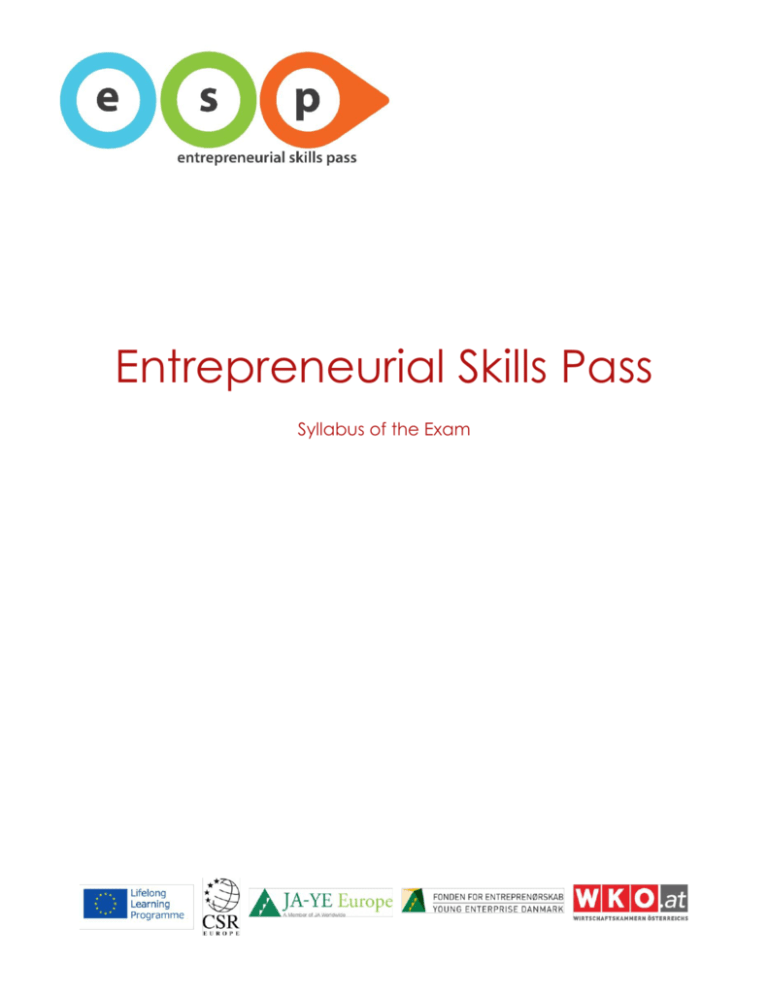
Entrepreneurial Skills Pass Syllabus of the Exam Introduction The Entrepreneurial Skills Pass (ESP) is a new international qualification that certifies students (aged 16-18), who have had a real entrepreneurship experience, have gained the necessary knowledge, skills and competences to start a business or to be successfully employed. Accordingly to the European Qualifications Framework for Lifelong Learning 1 , within ESP, “qualification” means a formal outcome of an assessment and validation process which is obtained when a competent body determines that an individual has achieved learning outcomes to given standards. This is the reason why ESP consists of three key elements: • A real entrepreneurial experience that takes place in school during the year and which includes mentoring from experienced business people and through competitions. Working in groups and under the guidance of teachers and business volunteers, students have the opportunity to set up and manage a mini-company. As part of this programme they develop the ability to generate ideas and turn them into action; they learn how to work in a team, take initiative and accept responsibility; they experience what it means to manage a real enterprise; they understand how economics and finance contribute to the project’s success; they apply math, science, language, writing, technological or specialized skills in a practical way. • A self-assessment tool where students involved in the entrepreneurial experience reflect on their own entrepreneurial competences as they progress through the year. Sense of initiative and entrepreneurship 2 is the key competence addressed with a particular focus on creativity, perseverance, resourcefulness, self-confidence, taking initiative, taking responsibility, teamwork. • An online examination to certify the business, economics and finance knowledge students have gained as a result of this experience. The ESP is designed to be a PASS to further opportunities recognized by small and large businesses, top higher education institutions and international organisations across Europe. The ESP platform will be a place where young people can go to find further opportunities to pursue their business ideas, their career development, or training and education possibilities. The ESP will be something that students can add to their curriculum or LinkedIn profiles which is a great asset at an age when they do not yet have much work experience. The following picture gives an idea of ESP learning path. European Commission, European Qualifications Framework for Lifelong Learning, 2008. As defined in the Recommendation 2006/962/EC of the European Parliament and of the Council of 18 December 2006 on Key Competences for Lifelong Learning [Official Journal L 394 of 30.12.2006]. 1 2 2 Figure 1 - ESP: a complex learning path 3 Entrepreneurial Skills Pass The final examination aims at assessing, validating and certifying students’ theoretical and factual knowledge (facts, principles, theories and practices related to a field of work or study) as well as their cognitive and practical skills (the ability to apply knowledge and use know-how to complete tasks and solve problems) about the most important basic business issues and concepts. It is focused on four main categories that describe the main areas of knowledge students should have acquired during their entrepreneurial experience. Each category is composed of a set of topics. They are defined in terms of learning outcomes with a statement describing what a learner should know, understand and/or be able to do on completion of the learning process (European Commission, 2008). Each learning outcome is further described alongside the didactic objectives, which provide the detail about what the student is expected to learn, know and understand for each topic. The fundamental objective of the Entrepreneurial Skills Pass is to show a direct link between the activities experienced in the entrepreneurial experience and the exam. Therefore, its questions are focused on skill-based tasks with an emphasis upon applied understanding and practical scenarios rather than solely assessing knowledge and factual recall. 4 ESP syllabus CATEGORY 1. General understanding of organizations TOPICS 1.1 Entrepreneurship I can explain what an enterprise/entrepreneur is and what role they have in society 1.2 Vision, mission and ethics I understand the importance of a clear mission and core values and I can relate to ethical issues 1.3 Structure I know how organizations are structured 1.4 Leadership OBJECTIVES The student should be able to… Explain what an enterprise is and identify the key characteristics and skills of an entrepreneur. Explain why individuals set up a business and what the key requirements are in order to starting it up. Demonstrate an understanding of the opportunities and risks of entrepreneurship. Describe the contribution of entrepreneurship for society, with reference to different contexts (e.g. social, cultural, economic, etc.). Demonstrate an understanding of what is meant by a corporate mission, why it is important and the need to express it in a clear and simple form. Explain the difference between a company’s mission and its values. Demonstrate an understanding of the importance of the ethical dimension for a business and what is meant by corporate social responsibility. Demonstrate a good knowledge of organization structure and working environment. Read an organizational chart understanding who is responsible for what and who can issue instructions to whom. Identify and recognize the main roles in an organization and the related responsibilities and duties. Demonstrate an understanding of what is meant by leadership. 5 I know why leadership is important 1.5 Competences in a team I can explain what kind of competences are needed in a team Demonstrate an understanding of the value and advantages of working in a group. Demonstrate an understanding of what is needed for effective team working. Demonstrate an understanding of group dynamics and how individual qualities and contributions can affect team working. 1.6 Value of ICT Demonstrate a critical understanding of the advantages and disadvantages of the Information and Communication Technologies for both individuals and organizations. Explain the importance of Information and Communication Technologies with a particular focus upon communication, networking, research, process management and security/privacy issues. I know how ICT help organizations to be more effective 1.7 Personal development: career options and intrapreneurship I am more aware of my weaknesses and strengths and I am able to identify a possible career option for me 2. Main steps and legal requirements Describe and explain the key qualities of an effective leader. 2.1 Business Life Cycle I understand what a business is and I know how to develop it (I can explain the process) 2.2 Starting up I know that all businesses need a formal basis to operate 6 Demonstrate an understanding of the career opportunities for both entrepreneurs and “intra”-preneurs. Demonstrate an appreciation of both career opportunities and challenges as a means to enhance employability. Demonstrate an understanding of the importance of individual knowledge and skills as a means to enhance employability. Demonstrate an understanding of the most important legal forms of business ownership and their relative advantages and disadvantages. Demonstrate an understanding of the distinctive features of different types of business activities. Explain the process and necessary steps to raise funding, in setting up and managing a business. Demonstrate an understanding of the key requirements for a business in its start-up phase. Explain the main legal requirements for a business in its start-up phase. 2.3 Operating I know that organizations have to comply with legal requirements regarding accounting and tax 2.4 Liquidation I know what liquidation is 2.5 IPR I know that there are various IPR rules and why they are important 3. From idea generation to the market 3.1 Idea generation I can come up with new ideas working both as an individual and collaboratively in teams 3.2 Business opportunity I am able to turn an idea into a business opportunity 3.3 Kinds of innovation I know what innovation is and that there are different kinds of innovation 3.4 Market research I am able to carry out market research and analyze its findings 7 Demonstrate an understanding what a business needs to do to run its operations. Explain the key day to day demands in running a business. Identify and explain the main legal principles that support business accounting and taxation. Explain what is meant by the business liquidation process and the difference from business failure. Explain the necessary steps needed to liquidate a company. Demonstrate an understanding of the purpose and scope of Intellectual Property Rules. Explain and contrast the different types of Intellectual Property Rules (e.g. copyright, trademark or patent). Demonstrate an understanding of what is meant by protecting a business idea and the practical commercial benefits of Intellectual Property Rules. Recognize a viable commercial idea. Demonstrate an understanding of different creative techniques suitable for individuals or groups. Describe and explain different methods for generating and evaluating commercial ideas. Identify the necessary requirements to turn an idea into a business opportunity. Demonstrate an understanding of the importance of critical thinking for innovation and business development. Recognize and explain different approaches to innovation both with and without supporting technology. Demonstrate an understanding of, and an ability to describe and explain applied market research. Demonstrate an understanding of the importance for business to have a customer-user focus. 3.5 Selling tactics I am able to identify effective sales strategies 3.6 Marketing strategies: tactics, techniques and resources I know what marketing is about, and I know it is important to use various marketing tactics techniques and resources (including the online tools) 3.7 Internationalization I know how to explore the international options for my business. 3.8 Business Plan I know what a business plan is and I am able to develop it 4. Financial resources and budgeting 4.1 Funding opportunities I can identify different funding opportunities 4.2 Costing and pricing I am able to calculate the costs of a product or service and to define its price 8 Demonstrate an understanding of different pricing policies. Explain the importance of being able to identify and choose an appropriate selling channel and related tactic. Demonstrate an understanding of the marketing concept. Explain the key elements of a marketing strategy. Critically reflect on the role of technologies and social media for marketing. Identify, choose and apply suitable marketing tools and channels for a given scenario. Demonstrate an understanding of the importance of globalization and the advantages and disadvantages of international trade. Explain the contribution of technology to support international trade. Describe and explain the different opportunities and challenges faced by companies trading domestically and internationally. Describe and explain the purpose and content of a business plan. Demonstrate a knowledge and understanding of the necessary steps in developing a business plan. Describe and explain the need for business to raise capital. Demonstrate an understanding of the relationship between different sources of business finance and their associated costs Describe and explain different forms of business risks. Describe and explain the different factors that can affect price. Demonstrate an understanding of the relationship between costs and price. Demonstrate an understanding of basic techniques to calculate costs and price of a product/service. 4.3 Budget and Financial analysis I know what a budget is and what a s financial statement is 4.4 Key terminology I know how a business or an organization generates profit and I understand the key terminology about financial issues Demonstrate an understanding of the difference and the purpose of financial statement and a budget. Demonstrate an understanding of the purpose and use of both financial statements and cash budgets. Demonstrate an understanding of key terms related to business environment and financial issues. ESP exam The ESP Exam is delivered online through an online platform that is available only in a specialized test centers where students can go and take the exam in a formal setting. Here an overview of the main characteristics of the exam: Total number of questions: 20-30 Possible type of questions: o Multiple Choices Questions (with 4 possible answers of which 1 or 2 correct) o Questions with drop-down menu (with options to choose) o Matching questions (with elements to match) Format of the test: o Single questions Or o Questions with short scenario Length of the test: 1 hour 9




